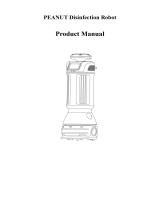
Keenon Robotics Co.,Ltd
for charging; if the administrator cancels during charging, the machine will trigger automatic
charge-back again when the electric quantity running the robot is lower than the [Minimum Power
Consumption].
The operating steps for setting the working time of automatic charge-back of the robot are
specifically as below:
The robot is provided with the function of intelligent automatic charge-back. In PEANUT APP, the
user can set the working time of the robot as below:
①After entering the [Robot Settings] page, select [Power Management] to find the function
setting column of “Working Hours”.
②Click the [Add] button for working hours to enter the setup interface of time.
③Enter the setup page of time, pop up the selection page of time, click [OK] on the right after
selecting the time, and the time will be displayed at the start time on the left (enter the setup page of
time, and the selection page of time automatically popped up will correspond to the start time).
④If the start time and end time are changed, click the displayed time (e.g. 9:00), and the selection
page of time will be displayed from bottom to top. After selecting the time, the user must click [OK],
and the time will be displayed in the corresponding position.
⑤The number of working days is seven by default, and the machine will automatically return to
the charging pile for charging from the end of each working day; the user can choose the specific
working day as needed; if “I” is selected, the machine will only work on Monday, and will
automatically return to the charging pile for charging after the work ends.
⑥Set the time and working day well, and click the [Save] button. The added working hours are
valid, defaulted as on, and the ON button is orange.
⑦The added working hours cannot be revised, but can be deleted or closed. The close button is
grayish white; when the working period is in a closed state, the machine will not automatically go to
the charging pile for charging when it reaches the end time of working.
3.3.3 Adjust the Volume Level
If the system menu bar is displayed at the bottom of the screen, directly click the volume button to
adjust the volume. If not, follow the following steps:

























